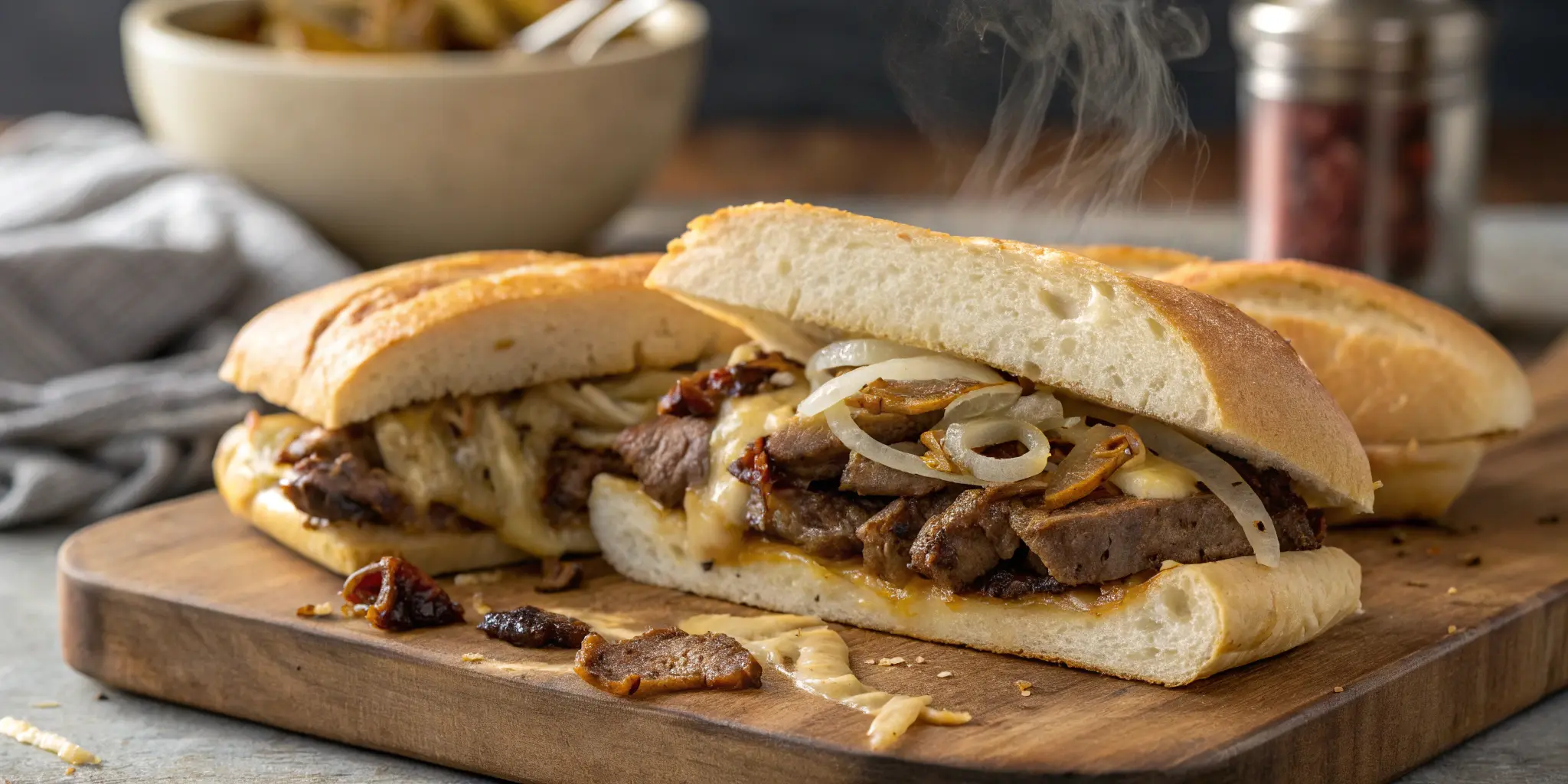The Ultimate Philly Cheesesteak Recipe: 3 Easy, Juicy, Flavor-Packed Steps
Table of Contents
A Culinary Journey to the Heart of Philadelphia
There are flavors that transport us, aromas that revive distant memories. For me, the Philly Cheesesteak is much more than just a sandwich; it’s a culinary madeleine de Proust, a symbol of conviviality and generosity.
Every bite of this emblematic Philadelphia delight is a promise of juiciness, intense flavors, and a melting texture that comforts the soul.
Today, I invite you to embark with me on a culinary journey, where we will recreate together the magic of this legendary sandwich, in just three simple, juicy, and flavor-packed steps.
Get ready to transform your kitchen into a true temple of taste, where authenticity and gourmet delight will be the watchwords.
You will discover how each ingredient plays a crucial role in creating this masterpiece, and how simple techniques can elevate your Philly Cheesesteak recipe to an unparalleled level.
Whether you are a seasoned cook or a novice seeking new culinary adventures, this detailed guide will accompany you step by step to ensure your homemade Philly Cheesesteak is a resounding success.
Let yourself be guided by the enticing aromas of grilled meat and caramelized onions, and get ready to impress your loved ones with this icon of American cuisine.
Your palate will thank you, and you will undoubtedly become the undisputed master of the Philly Cheesesteak in your circle.
Essential Ingredients for a True Homemade Philly Cheesesteak
To succeed in making an authentic Philly Cheesesteak, the quality of the ingredients is paramount.
Each component contributes to the perfect balance of flavors and textures that characterize this emblematic sandwich.
Never underestimate the importance of choosing fresh, high-quality products, as they will make all the difference in the final result of your Philly Cheesesteak recipe.
The Meat: The Heart of Your Philly Cheesesteak
The choice of meat is undoubtedly the most crucial step for a successful Philly Cheesesteak.
It is what provides the richness and characteristic umami flavor.
You have two main options, each with its own advantages:
- Type of meat: Thinly sliced ribeye is the traditional and preferred choice of connoisseurs.Ribeye is renowned for its generous marbling, meaning the presence of fine intramuscular fat veins.This fat melts during cooking, giving the meat incomparable tenderness and juiciness.Sirloin is an excellent alternative, leaner but just as flavorful if cut very thinly.The key is the thinness of the cut, which allows for quick and even cooking, ensuring tender, non-chewy meat.A thickness of about 1 to 2 millimeters is ideal.
- Preparation: To facilitate this ultra-thin slicing, a little chef’s secret is to slightly freeze the meat for about 20 to 30 minutes before slicing it.This short freezing period will firm up the meat without hardening it, allowing you to slice it into incredibly thin strips, ideally between 1 and 2 millimeters thick.Always use a very sharp knife and cut against the grain of the meat to maximize its tenderness.The thinner the slices, the faster they will cook and the more they will absorb flavors, thus contributing to the juiciness of your Philly Cheesesteak.If you have a good butcher, don’t hesitate to ask them to prepare ribeye slices for Philly Cheesesteak; they will know exactly what you need.
The Cheese: The Indispensable Creamy Touch
The cheese is the melting soul of your Philly Cheesesteak.
It brings that creaminess and milky flavor that pairs so well with the meat and onions.
Several options are available to you, from the most traditional to the most daring:
- Traditional options: Provolone is the most commonly used cheese in authentic cheesesteaks.You can opt for mild provolone for a subtle flavor that doesn’t overpower the meat, or sharp provolone for a more pronounced character.For purists and lovers of the most faithful Philadelphia experience, Cheez Whiz is an essential option.Although controversial for some, this melted cheese provides an incredibly creamy texture and a unique flavor that has its devotees.It melts instantly and perfectly coats each piece of meat, creating a perfect harmony.
- Other popular options: If provolone or Cheez Whiz are not to your taste or available, white American cheese is an excellent alternative.It melts beautifully and offers a mild, familiar flavor.Mozzarella can also be used for its ability to melt and stretch, although its flavor is less typical.The important thing is to choose a cheese that melts well and adds a creamy texture to your Philly Cheesesteak recipe.
Vegetables and Aromatics: For an Explosion of Flavors
Although meat and cheese are the stars, vegetables and aromatics are the supporting actors that enhance the whole, adding depth and complexity to your Philly Cheesesteak.
- Onions: Yellow onions, thinly sliced, are a non-negotiable ingredient.Their slow cooking and caramelization bring a natural sweetness and umami flavor that perfectly complement the richness of the meat.They must be tender and slightly golden, almost candied, to release all their flavors.
- Bell peppers (optional): Green bell peppers, julienned, are a popular but optional addition.They add a touch of freshness, a slight bitterness, and a vibrant color that contrasts with the richness of the rest of the sandwich.If you like more complex flavors, feel free to include them.
- Seasoning: Simple seasoning is enough to enhance the natural flavors of the ingredients.Salt and freshly ground black pepper are essential.A pinch of garlic powder adds a subtle aromatic note that pairs wonderfully with the meat and onions.Don’t be afraid to adjust the quantities according to your personal preferences for your Philly Cheesesteak recipe.
The Bread: The Perfect Support
The bread is much more than just a container; it’s the foundation of your Philly Cheesesteak.
It must be able to support the generous filling without falling apart, while offering a pleasant texture.
- Type of bread: Hoagie rolls (also called sub rolls or hero rolls) are the authentic choice.They should be fresh, soft on the inside to absorb the cooking juices, but sturdy enough on the outside to keep the sandwich intact.Avoid overly crispy bread that could hurt the palate or overly soft bread that would disintegrate.A good hoagie roll guarantees that every bite of your Philly Cheesesteak will be perfect.
Ingredients Table for Your Philly Cheesesteak Recipe
To help you prepare your homemade Philly Cheesesteak, here is a summary table of the ingredients needed for two generous sandwiches.
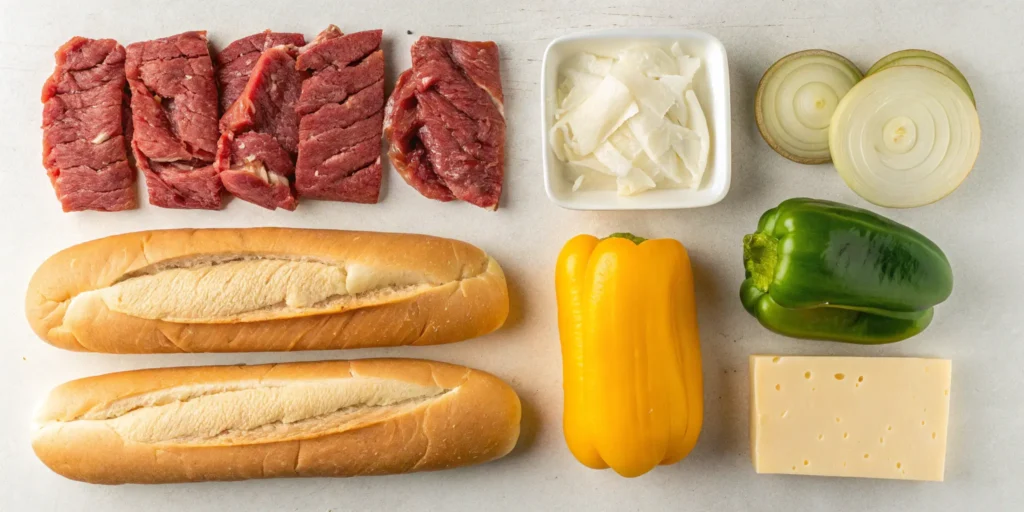
You can easily adjust the quantities based on the number of people you want to treat with this delicious Philly Cheesesteak recipe.
| Ingredient | Quantity (for 2 sandwiches) | Notes |
|---|---|---|
| Ribeye steak | 300-400g | Sliced very thinly (1-2 mm thick) |
| Vegetable oil | 1 tablespoon | For cooking meat and vegetables, or canola oil |
| Yellow onion | 1 medium | Thinly sliced, about 150g |
| Green bell pepper | 1/2 (optional) | Julienne, about 75g |
| Salt | To taste | Preferably fine sea salt |
| Black pepper | To taste | Freshly ground for optimal flavor |
| Garlic powder | 1/2 teaspoon | To enhance flavors |
| Provolone cheese | 4-6 slices | Or Cheez Whiz, American cheese, depending on your preference |
| Hoagie rolls | 2 | Fresh and soft, about 20-25 cm long |
This table provides a clear overview of the quantities needed for your Philly Cheesesteak recipe.
Remember that the quality of the ingredients is the key to an exceptional result.
Take the time to choose the best available products to guarantee an unforgettable culinary experience.
3 Simple Steps for a Juicy and Flavorful Philly Cheesesteak
Now that you have gathered all the necessary ingredients, it’s time to take action.
Preparing a Philly Cheesesteak is surprisingly simple, and by following these three key steps, you will achieve a result worthy of Philadelphia’s best establishments.
Each step is designed to maximize flavors and textures, guaranteeing you a juicy, flavorful, and perfectly balanced Philly Cheesesteak.
Step 1: Prepare Ingredients and Cook Onions
This first step is fundamental to laying the groundwork for an exceptional Philly Cheesesteak.
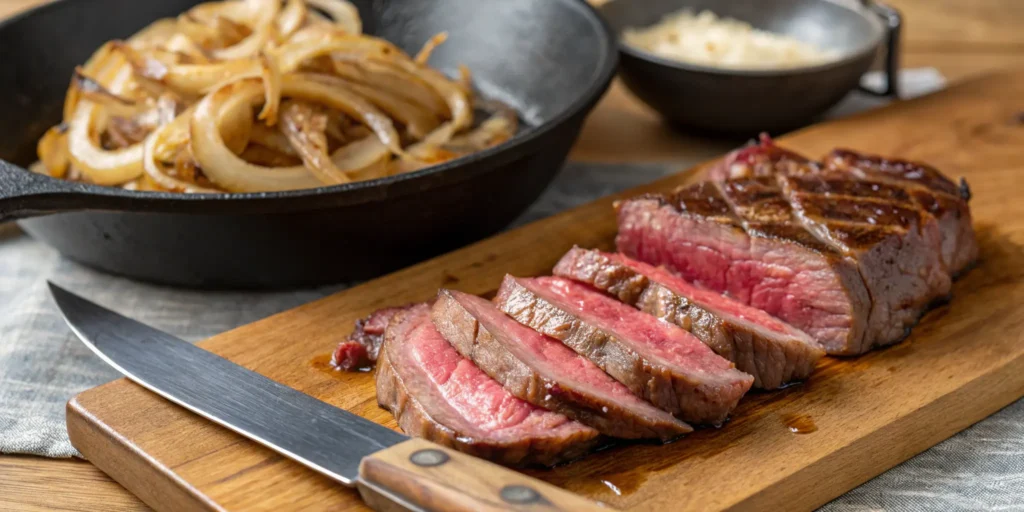
Proper ingredient preparation and perfect onion cooking are essential to develop the flavors that will make your sandwich famous.
- Slice the meat: If you haven’t had the chance to find thinly sliced meat, now is the time to put your butchering skills to the test.To facilitate this delicate task, place your ribeye or sirloin cut in the freezer for about 20 to 30 minutes.This short freezing period will firm up the meat without hardening it, allowing you to slice it into incredibly thin strips, ideally between 1 and 2 millimeters thick.Always use a very sharp knife and cut against the grain of the meat to maximize its tenderness.The thinner the slices, the faster they will cook and the more they will absorb flavors, thus contributing to the juiciness of your Philly Cheesesteak.If you have a good butcher, don’t hesitate to ask them to prepare ribeye slices for Philly Cheesesteak; they will know exactly what you need.
- Prepare the vegetables: While the meat is firming up, take care of the vegetables.Thinly slice the yellow onion into strips.If you have decided to include green bell peppers in your Philly Cheesesteak recipe, also julienne them thinly.The thinness of the cut is important here too, as it ensures quick cooking and harmonious integration of the vegetables into the sandwich.
- Cook the onions: This is where the magic begins.In a large cast-iron skillet or heavy-bottomed pan, heat one tablespoon of vegetable oil over medium heat.Once the oil is hot, add the thinly sliced onions.Sauté them gently, stirring occasionally, until they become translucent, then begin to brown and caramelize.This process will take about 8 to 10 minutes.The caramelization of the onions is essential; it develops a natural sweetness and depth of flavor that are characteristic of a good Philly Cheesesteak.If you are using bell peppers, add them to the onions during the last 3-4 minutes of cooking so they soften slightly while retaining a bit of crunch.Once the onions (and bell peppers) are perfectly cooked, remove them from the pan and set them aside in a bowl.They will wait their turn to join the meat and cheese.
Step 2: Cook the Meat and Assemble
This step is the heart of the Philly Cheesesteak recipe, where the meat is cooked to perfection and mixed with the cheese to create that irresistibly melting filling.
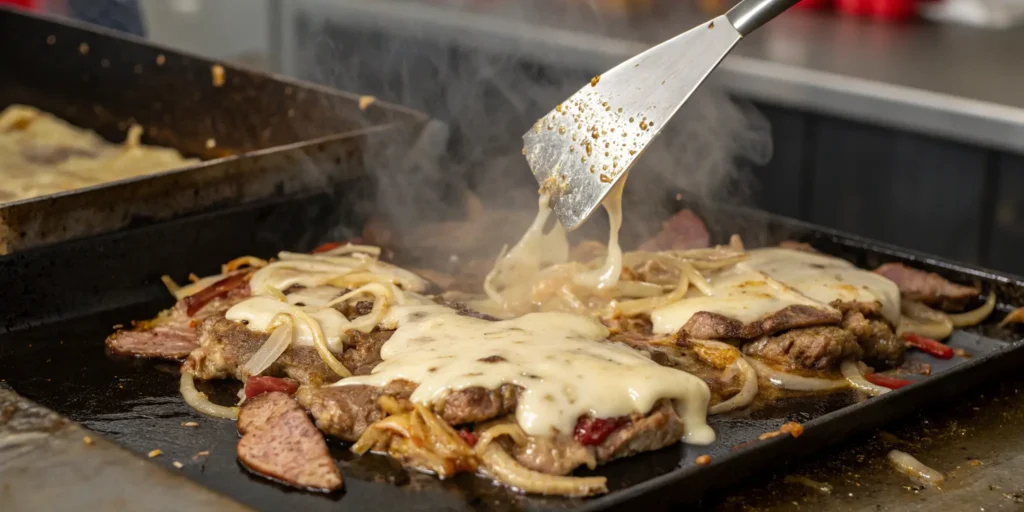
- Cook the meat: Increase the heat to medium-high in the same pan used for the onions.If necessary, add a small amount of vegetable oil to prevent the meat from sticking.Once the pan is hot, place the thin slices of meat in a single layer.Let them brown without stirring for 1 to 2 minutes.This initial searing is crucial to develop a nice crust and trap the juices.Then, using a wooden or metal spatula, begin to break the meat into small pieces.Season generously with salt, freshly ground black pepper, and garlic powder.Continue to cook and chop the meat, turning it regularly, until it is well browned and cooked to your liking, which will take about 3 to 5 minutes.The key is not to overcook the meat so that it remains juicy and tender.You will notice that the edges of the meat will start to crisp slightly, adding a pleasant texture to your Philly Cheesesteak recipe.
- Mix and cheese: Once the meat is perfectly cooked, reincorporate the caramelized onions (and bell peppers if you used them) into the pan.Mix everything well so that all the flavors combine harmoniously.Then create mounds of this mixture in the pan, corresponding to the number of sandwiches you are preparing.Generously arrange the cheese slices (provolone, American cheese, or Cheez Whiz) on each mound of meat and vegetables.To help the cheese melt quickly and evenly, you can pour a tablespoon of water on the side of the pan and immediately cover with a lid.The steam created will melt the cheese in 1 to 2 minutes, making it perfectly gooey and enveloping.Melted cheese is the element that binds all the ingredients together, creating that creamy and irresistible texture that makes the Philly Cheesesteak famous.
Step 3: The Perfect Sandwich Assembly
The final step is assembly, where all the elements come together to form the iconic sandwich.
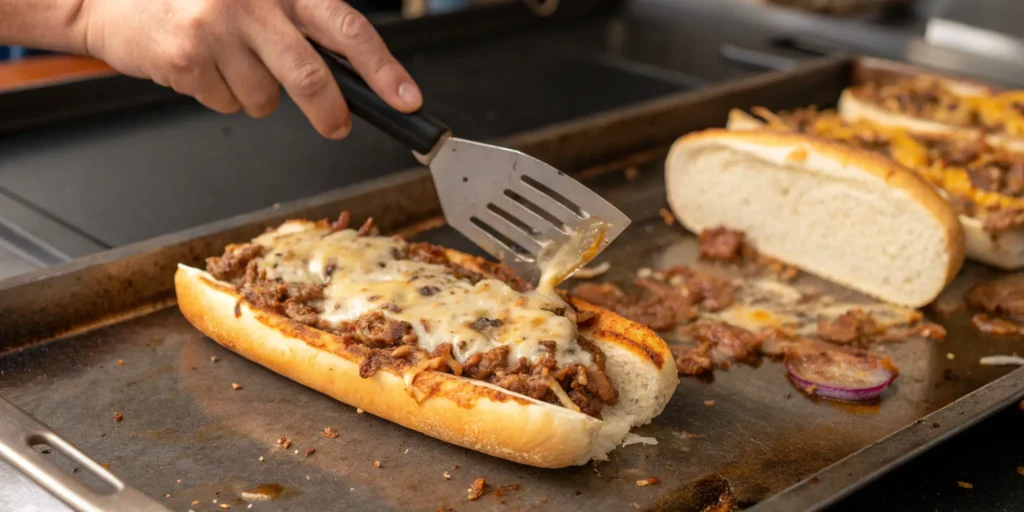
Proper assembly is essential to ensure that every bite of your Philly Cheesesteak is a complete and satisfying experience.
- Prepare the bread: While the cheese is melting, prepare your hoagie rolls.Gently open them without completely separating them.If you like bread that is slightly crispy on the outside and soft on the inside, you can lightly toast them.To do this, place them cut-side down in another dry, hot pan for a few minutes, or quickly pass them under the oven broiler.This step adds an extra textural dimension and prevents the bread from becoming soggy from the filling’s juices.Well-prepared bread is the foundation of an excellent Philly Cheesesteak.
- Fill: Now for the action!Using a large, sturdy spatula, carefully transfer the mixture of meat, onions, and melted cheese directly from the pan into the toasted hoagie rolls.Make sure to distribute the filling evenly along the entire length of the bread, and that the melted cheese generously coats the meat.Don’t hesitate to be generous; a Philly Cheesesteak is never too full.The heat from the mixture will slightly soften the inside of the bread, creating a perfect contrast with the crispy exterior.
- Serve: Your Philly Cheesesteak is ready!Serve it immediately, while it’s hot and the cheese is still gooey.Accompany it with fries, a fresh salad, or simply enjoy it as is.Every bite will transport you directly to the streets of Philadelphia, savoring a piece of culinary history.
Tips and Tricks for an Unforgettable Philly Cheesesteak
To elevate your Philly Cheesesteak recipe to a culinary work of art, here are some additional tips that will make all the difference:
- Pan temperature: Make sure your pan is very hot before adding the meat.A sufficiently hot pan allows for quick and efficient searing, creating a beautiful golden crust on the meat and trapping the juices inside.This is crucial for the juiciness of your Philly Cheesesteak.
- Don’t overcrowd the pan: Cook the meat in batches if necessary.Overcrowding the pan will lower the temperature and cause the meat to boil instead of sear, making it less flavorful and less tender.Patience is a virtue in cooking, especially for a perfect Philly Cheesesteak.
- Chopping the meat: Using two spatulas can facilitate chopping the meat during cooking.This allows you to break it into small, uniform pieces, which is essential for a pleasant texture in your Philly Cheesesteak recipe.
- Cheese variations: Feel free to experiment with different cheeses if you wish.A mix of provolone and mozzarella can offer an interesting texture and flavor.Some even like to add a little Swiss cheese for a touch of originality.The important thing is to choose a cheese that melts well and complements the flavors of the meat and onions.
- Gourmet additions: For those who like bolder flavors, you can add sautéed mushrooms, pickled hot peppers (cherry peppers), or even a little hot sauce to your Philly Cheesesteak.These additions can personalize your sandwich and make it even more unique.
- The secret to juiciness: If your meat tends to dry out, you can add a tablespoon of beef broth or water when adding the cheese and covering the pan.The steam created will help keep the meat moist and the cheese will melt even better.
FAQ: Everything You Need to Know About the Philly Cheesesteak Recipe
You have questions about preparing your Philly Cheesesteak recipe? Here are the answers to the most frequently asked questions to help you master this culinary classic.
Q: What is the best meat for a Philly Cheesesteak?
A: Ribeye is unanimously considered the best meat for a Philly Cheesesteak due to its marbling, which gives it exceptional tenderness and juiciness.
Sirloin is a good alternative.
Q: Can I use a cheese other than provolone for my Philly Cheesesteak recipe?
A: Yes, although provolone and Cheez Whiz are the traditional choices, you can use white American cheese, mozzarella, or even a blend of cheeses according to your preferences for your Philly Cheesesteak recipe.
Q: How do I cut the meat so thinly for the Philly Cheesesteak?
A: To make slicing easier, place the meat in the freezer for 20 to 30 minutes before cutting it.
Use a very sharp knife and cut against the grain to get very thin slices, ideal for your Philly Cheesesteak.
Q: Is it necessary to add bell peppers to the Philly Cheesesteak recipe?
A: No, green bell peppers are optional.
The traditional Philly Cheesesteak mainly consists of meat and caramelized onions.
It’s a matter of personal preference, but they are not a mandatory ingredient for an authentic Philly Cheesesteak recipe.
Q: What is the origin of the Philly Cheesesteak?
A: The Philly Cheesesteak originated in Philadelphia, Pennsylvania, in the early 20th century.
It was created by Pat Olivieri, a hot dog vendor, who had the idea of grilling chopped beef and serving it in a bun.
Cheese was added later, and the sandwich quickly became a city staple.
Q: Can the Philly Cheesesteak be prepared in advance?
A: It is best to enjoy the Philly Cheesesteak immediately after preparation to fully appreciate its optimal texture and flavors.
The meat and cheese can be prepared in advance and reheated, but the bread should be toasted and the sandwich assembled just before serving to prevent it from becoming soggy.
The Authentic Taste of Philadelphia at Your Table
Preparing a homemade Philly Cheesesteak is a rewarding experience that allows you to savor the essence of American street food in the comfort of your home.
With this simple three-step Philly Cheesesteak recipe, you have all the keys to create a juicy, flavorful, and unforgettable sandwich that will delight your taste buds and those of your guests.
Don’t wait any longer, get started and discover why the Philly Cheesesteak is much more than just a meal: it’s a culinary legend to share.
Enjoy your meal!

